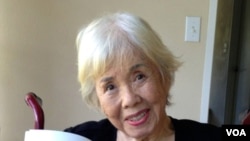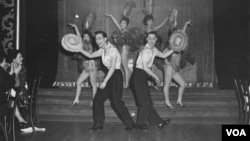When Arthur Dong was growing up in San Francisco in the 1950s and 60s, he used to walk by a nightclub just outside of Chinatown.
"I remember distinctly looking at the glass display case with all these wonderful black and white photos of Chinese people, but dressed in zoot suits and 1940s kind of gowns and tuxedos,” he said. “And I had never seen Chinese dressed like that."
The club, which opened in 1938, was called Forbidden City after the imperial palace in China. It was part of a flourishing Chinese-American nightclub scene in the 1940s and 50s that paved the way for future Asian-American performers who defied racial and cultural barriers to pursue their showbiz dreams.
In 1989, Dong captured that little-known chapter of entertainment history in his documentary “Forbidden City, USA.” The film has now been digitally remastered and Dong has turned his research into a new book, Forbidden City, USA: Chinese American Nightclubs, 1936-1970.
Back when Dong decided to make a documentary about the Chinese-American nightclub scene, few people wanted to talk about it.
“They were ashamed of the clubs,” he said. “You know, the whole notion of women wearing scanty clothing, showing their legs in public, was taboo for the conservative Chinese community at that time. So I think the Chinese community really wanted to forget about these clubs."
Mai Tai Sing followed her show business dreams by starting out as a dancer in the 1940s, at a time when conservative Chinese parents did not want their children to become entertainers.
"Because it's not a high-class job,” she said. “It's low-grade — dancing, showing your legs and everything. Then it got exciting."
Sing, now 91 and living in Hawaii, recalls Forbidden City had it all — dancers, comedians and singers like Larry Ching, who was billed as the Chinese Frank Sinatra.
The club was even profiled in major media outlets, including Life magazine. But that didn't shield the performers from racial taunts from a mostly white audience.
“So even though you are the stars of the show, they still feel superior to you and make racist remarks to your face or shout it out from the audience,” said writer and broadcaster Ben Fong-Torres. “And I think that was pretty difficult for most of these entertainers to take. But as Larry Ching said, 'I had to; otherwise I wouldn't be in the business.'"
During the club’s heyday, celebrities such as Bob Hope, Bing Crosby and Duke Ellington came to see the shows.
"This was quite a bold experiment, and it shattered conceptions that people might have had about other people of color,” Fong-Torres said. “And it was one of the major platforms for a change of mind, a change of attitude, a change of perception on the part of those who came in."
Audiences included servicemen, locals and busloads of tourists. Singer Jimmy Borges, who was born in Hawaii to a Portuguese, Chinese and Hawaiian family, recalls the memorable reaction of one audience member after he sang the song, Fever.
“And this lady, she was looking at me and there was this look in her eye of complete mystification. And she says to her husband, 'Oh, Charlie, he sings just like a white man.' And that was so funny,” Borges recalled. “I started to laugh because she didn't mean it in a bad way. She meant it like she had never seen anybody like me sing a song that was made famous by a white person."
In 1962, Forbidden City's founder sold the club to dancer Coby Yee and her family. Yee, who is now 88, says it was good to see some of the performers who honed their skills at the club become famous on TV and in the movies.
"I remember Pat Morita, who I shared a dressing room with, and he later was in 'Karate Kid.' And there was Sammee Tong, who was in 'Bachelor Father,' with John Forsythe. And then there was Jack Soo, who became famous in 'Barney Miller.' He also did 'Flower Drum Song,'" she said.
Dong says those pioneering performers continue to inspire young Asian Americans today.
"They knew what they wanted," he said. "They had dreams. They had goals. And they weren't going to let larger societal bigotry get in their way. And they had fun doing it; these folks had a lot of fun struggling to achieve their dreams."
But, he reflects, it’s still a struggle to break into mainstream entertainment, “to be recognized for your talent and not be hindered by the fact that you're a particular color."
Forbidden City will screen along with a presentation of Dong’s new book in Los Angeles at the Asian Pacific Film Festival on April 26, 2015.










